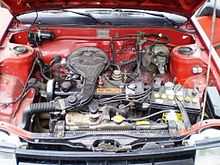Transverse engine

A transverse engine is an engine mounted in a vehicle so that the engine's crankshaft axis is perpendicular to the long axis of the vehicle. Many modern front wheel drive vehicles use this engine mounting configuration. (Most rear wheel drive vehicles use a longitudinal engine configuration, where the engine's crankshaft axis is parallel to the long axis of the vehicle.)
History

The Critchley light car, made by the Daimler Motor Company in 1899, had a transverse engine with belt drive to the rear axle.[1][2] A 1911 front-wheel drive car had a transverse engine with a clutch at each end, driving the front wheels directly.
The first successful transverse-engine cars were the two-cylinder DKW "Front" series of cars, which first appeared in 1931. After the Second World War, SAAB used the configuration in their first model, the Saab 92, in 1947.[3] The arrangement was also used for Borgward's Goliath and Hansa brand cars and in a few other German cars. However, it was with Alec Issigonis's Morris Mini and Austin Seven that the design gained acclaim, in 1959.
This design reached its ultimate extent starting with Dante Giacosa's elaboration of it for Fiat. He connected the engine to its gearbox by a shaft and set the differential off-center so that it could be connected to the gearbox more easily. The axleshafts from the differential to the wheels therefore differed in length, which would have made the car's steering asymmetrical were it not for their torsional stiffness being made the same. Now most small and small/medium sized cars built throughout the world use this arrangement.
The Lamborghini Miura used a transverse, mid-mounted 4.0 litre V12, a configuration that was unheard of in 1965, although now more common (e.g. Noble M12, Toyota MR2, Pontiac Fiero, Fiat X1/9)
The Land Rover LR2 Freelander, along with all Volvo models from 1998 on (including V8 models), employ a transversely-mounted engine in order to increase passenger space inside the vehicle. This has also allowed for improved safety in a frontal impact, due to more front to back engine compartment space being created. The result is a larger front crumple zone.[4][5]
Transverse engines have also been widely used in buses. In the United States they were offered in the early 1930s by Twin Coach and used with limited success in Dwight Austin's Pickwick Nite-Coach. Transverse bus engines first appeared widely in the Yellow Coach 719, using Dwight Austin's V-drive; they continued in common use until the 1990s, though shorter V-configuration engines in a straight in "T-drive" configuration became common in the 1960s. They were also used in the British Leyland Atlantean and in many transit buses and nearly all modern double decker buses. They have also been widely used by Scania,[6] MAN, Volvo and Renault's bus divisions.
Position placement of transverse engines
Engines may be placed in two main positions within the motor car:
- Front-engine transversely-mounted / Front-wheel drive
- Rear mid-engine transversely-mounted / Rear-wheel drive
Common types of transversely placed engines
Space allowed for engines within the front wheel wells is commonly limited to the following:
- Single cylinder
- Inline-two
- Inline-three
- Inline-four
- Inline-five
- V4
- V6
Alternative convention with twin-cylinder motorcycles

The description of the orientation of V-twin and flat-twin motorcycle engines sometimes differs from the convention as stated above. Motorcycles with a V-twin engine mounted with its crankshaft mounted in line with the frame, e.g. the Honda CX series and several Moto Guzzis since the 1970s, are said to have "transverse" engines,[7][8] while motorcycles with a V-twin mounted with its crankshaft mounted perpendicular to the frame, e.g. most Ducatis since the 1970s and most Harley-Davidsons, are said to have "longitudinal" engines.[7][9] This convention uses the longest horizontal dimension (length or width) of the engine as its axis instead of the line of the crankshaft.
Notes
- ↑ Douglas-Scott-Montagu & Burgess-Wise 1995, p. 61.
- ↑ Smith 1972, p. 9.
- ↑ Robson 2010, p. 17.
- ↑ "Volvo S80". Retrieved 2007-10-11.
- ↑ "LR2 Safety Features". Archived from the original on 2007-07-07. Retrieved 2007-10-11.
- ↑ "Scania at Busworld 2005: New range of Scania buses and coaches". Retrieved 2007-10-11.
- ↑ 7.0 7.1 Clarke 2010, p. 44.
- ↑ Grubb 1975, p. 85.
- ↑ Grubb 1975, pp. 82, 83.
References
- Clarke, Massimo (2010). Modern Motorcycle Technology: How Every Part of Your Motorcycle Works. Minneapolis, MN USA: MotorBooks International. p. 44. ISBN 978-0-7603-3819-3. Retrieved 2013-05-31.
Moto Guzzi's tranverse V-twins are unique among motorcycles, while Ducati, in keeping with the classical school, uses a longitudinal V, meaning the axis of rotation of the crankshaft is transverse to the frame.
- Douglas-Scott-Montagu, Edward John Barrington & Burgess-Wise, David (1995). Daimler Century: The full history of Britain's oldest car maker. Sparkford, Nr Yeovil, Somerset, UK: Patrick Stephens. ISBN 1 85260 494 8.
- Grubb, Jake (March 1975). Linkletter, John A., ed. "Easy riders—the grand touring motorcycles for '75". Popular Mechanics (New York, NY USA: Hearst) 143 (3): 82–85, 126–127. ISSN 0032-4558. Retrieved 2013-05-31.
- Robson, Graham (2010). Saab 96 & V4. Poundbury, Dorchester, UK: Veloce. ISBN 978-1-845842-56-7. Retrieved 26 April 2015.
- Smith, Brian E. (1972). The Daimler Tradition. Isleworth, UK: Transport Bookman. ISBN 085184 014 0.